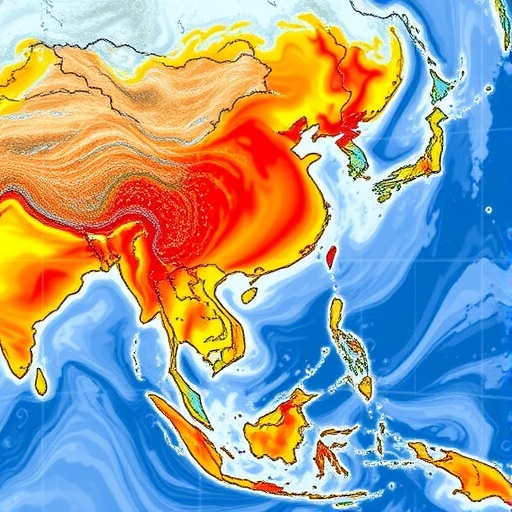The Asian monsoon system, a colossal driver of climatic rhythms across Asia, remains one of the most critical yet enigmatic phenomena in atmospheric science. Responsible for the seasonal redistribution of heat and moisture, the monsoon shapes weather, agriculture, water resources, and ultimately the livelihoods of billions throughout the continent. As global climate change reshapes atmospheric behavior, the scientific community is racing to enhance predictive capabilities that can better anticipate the monsoon’s dynamics. A comprehensive new review published in Advances in Atmospheric Sciences rigorously evaluates the current state of Asian monsoon climate prediction, highlighting significant progress alongside formidable challenges, while also charting an ambitious path forward amid the uncertainties imposed by global warming.
At the heart of this review is the recognition that seasonal forecasting of the Asian monsoon is not merely an academic pursuit but a societal imperative. The monsoon’s variability influences the success of staple crops, determines water availability, and governs disaster preparedness. Accurate seasonal forecasts, particularly of rainfall during the monsoon months, are vital for policy-making and economic planning in nations where millions live on subsistence agriculture or vulnerable coastal zones. Despite advancements, existing models continue to grapple with systematic biases and a changing framework of predictive precursors, necessitating deeper understanding and innovative methodologies.
The theoretical basis of monsoon predictability has traditionally revolved around three pillars: the El Niño-Southern Oscillation (ENSO), atmospheric teleconnections, and interactions between the monsoon system and surrounding oceanic bodies. ENSO dominates as the most influential driver, modulating monsoonal rainfall through its alternating warm and cold phases. Yet, it is increasingly evident that ENSO’s influence is multifaceted, with varying types of ENSO events producing distinct regional rainfall signatures across Asia. The review underscores that ENSO alone cannot explain the full spectrum of monsoon variability; other climate oscillations exert strong and sometimes competing influences.
Among these additional factors, the Indian Ocean Dipole (IOD) emerges as a significant modulator. Its positive and negative phases adjust sea surface temperatures and atmospheric circulation in ways that either reinforce or weaken the monsoon flow. Moreover, intricate land-atmosphere feedbacks, including soil moisture variability and vegetation dynamics, also interplay with atmospheric conditions, affecting precipitation patterns. Beyond the Indian and Pacific Oceans, remote influences from the Atlantic basin, North Pacific, and even polar regions introduce teleconnections that alter monsoon intensity and timing, further complicating the predictive landscape.
Compounding the natural complexity is the intensifying impact of anthropogenic climate change. Rising greenhouse gas concentrations and aerosol emissions are not just gradually shifting average monsoonal rainfall patterns but also amplifying the frequency and severity of extreme events. This heightened variability introduces an additional layer of unpredictability, challenging the robustness of current climate models. The review details how altered thermodynamic and dynamic processes in the atmosphere, driven by external forcings, herald new regimes in monsoon behavior that do not always conform to historical precedents.
On the forefront of scientific response are advancements in seasonal forecasting models, which now employ hybrid approaches combining dynamical simulations with empirical techniques. Dynamical models numerically solve fundamental physical equations governing the atmosphere and oceans, but they often falter in accurately simulating small-scale convective processes or the delicate coupling between land, sea, and air. Empirical models, drawing on statistical correlations between observed climate patterns, provide complementary insights but may struggle under nonstationary conditions induced by climate change. Hybrid models attempt to integrate the strengths of both paradigms to improve forecast skill.
Nonetheless, the review reveals that despite these technological strides, significant shortcomings persist. Systematic biases remain entrenched in simulating key processes such as monsoon onset, progression, and withdrawal. The inherently unstable nature of monsoon predictability arises from complex interactions among internal climate variability, extratropical teleconnections, and the evolving characteristics of ENSO and IOD events. This complexity leads to seasonal forecast reliability that often fluctuates unpredictably year-to-year, hampering confidence in operational use.
Addressing these challenges, the authors advocate for a multipronged research strategy that marries cutting-edge computational tools with fundamental climate science. One promising avenue lies in the application of artificial intelligence and machine learning techniques capable of distilling nonlinear relationships within vast atmospheric datasets, potentially uncovering new predictive signals. Improving model physics to better represent convection, cloud microphysics, and land-atmosphere coupling is equally crucial. Furthermore, the development of seamless prediction systems that extend sub-seasonal forecasts into seasonal scales could revolutionize disaster preparedness and agricultural planning.
Enhanced observational networks form another cornerstone of future progress. High-quality, continuous data streams from satellites, ground stations, ocean buoys, and radiosondes are imperative to constrain and validate models. International collaboration stands out as indispensable, facilitating data sharing and fostering coordinated research efforts across national boundaries. The review calls for integrated frameworks linking scientific research with operational forecasting centers to bridge the gap between theory and practical application.
Looking ahead, the review emphasizes that advancing Asian monsoon climate prediction will require sustained innovation, collaboration, and adaptability in the face of global climate change. The monsoon’s role as a life-sustaining force for billions demands no less than a scientific revolution in forecasting methodologies. As Prof. Bin Wang, lead author and distinguished professor at the University of Hawaii at Manoa, asserted, harnessing the synergy of emerging technologies and classical science will be critical to unlocking richer, more actionable predictions that can mitigate risk and guide adaptation strategies for Asia’s diverse and vulnerable communities.
Published as part of a special issue on global and regional monsoons curated by the World Climate Research Programme Monsoon Panel, this review stands as a landmark synthesis, shining a light on the path forward to mastering one of Earth’s most complex and consequential seasonal climate systems. The insights it offers promise to inspire a new generation of research and operational breakthroughs, ultimately paving the way toward a more climate-resilient Asia.
Subject of Research:
Asian Monsoon Climate Prediction, Climate Change Impacts on Monsoons, Seasonal Forecasting
Article Title:
Advancing Asian Monsoon Climate Prediction under Global Change: Progress, Challenges, and Outlook
News Publication Date:
25-Jul-2025
Image Credits:
Advances in Atmospheric Sciences




